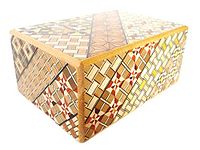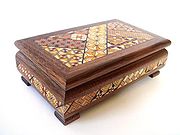
Yosegi
Encyclopedia


Parquetry
Parquetry is a geometric mosaic of wood pieces used for decorative effect. The two main uses of parquetry are as veneer patterns on furniture and block patterns for flooring. Parquet patterns are entirely geometrical and angular—squares, triangles, lozenges. The most popular parquet flooring...
which originated in Japan’s culturally rich Edo Period
Edo period
The , or , is a division of Japanese history which was ruled by the shoguns of the Tokugawa family, running from 1603 to 1868. The political entity of this period was the Tokugawa shogunate....
. It has been increasingly well reputed in foreign countries. The mosaic work is made by making best use of natural fine grains and textures of wood. Timbers of different colors are cut into oblong rods of desired sections.
Yosegi veneers are commonly found on the outside of Japanese secret boxes (himitsu-bako) or puzzle boxes, but may also be used to decorate many other items such as trays, chests, photo frames but the most common use is to decorate the surface of the Japanese yosegi Puzzle boxes. The boxes differ in sizes and number of moves. The length is usually measured in the traditional Japanese units of measurement
Japanese units of measurement
' is the traditional Japanese system of measurement. The name shakkanhō originates from the name of two of the units, the shaku, a unit of length, and the kan, a mass measurement.The system is Chinese in origin...
called the sun , with one sun equal to approximately 3 centimetres (1.2 in), hence a "5 sun" box would measure about 15 centimetres (5.9 in) in length. Boxes are most typically between 3 and 6 sun in length. Some well-known masters pride themselves in making unique boxes that do not follow any size guidelines. Explanation of boxes sizes and number of moves required to open a box can be found here: Puzzle Box sizes.
Spindle tree and ilex macropoda are used for white, aged Katsura tree for black, picrasma quassioides, mulberry and sumac for yellow, camphor tree and maackia for brown, American walnut tree for purple, Japanese cucumber tree for blue and Chinese cedar for red, etc.)
The rods are then glued together to form the section of geometrical pattern designed. The sectional surface is sliced into thin plates of wood, which are glued onto boxes and other handicraft works. To add to glaze and sturdiness of the surface, finish coatings are applied.
External links
- This is the detailed description of Yosegi Making process
- Web-site dedicated to Yosegi products
- Collection Ruth und Clemens Stupperich Yosegi - collection (catalogue)

